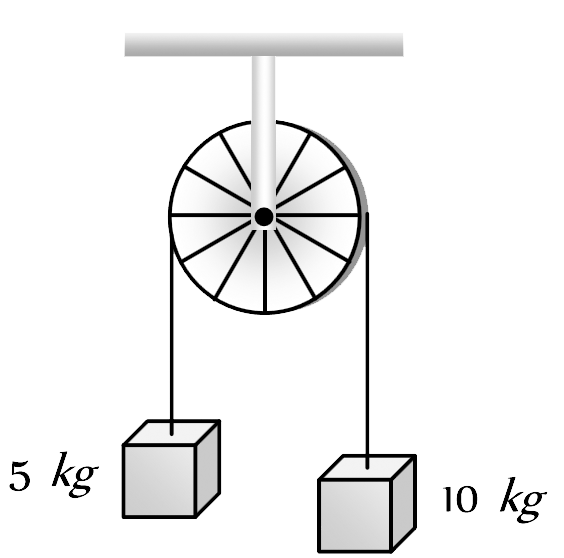The frictional force of the air on the body of mass 0.25kg, falling with an acceleration of 9.2 m/s2 will be (g=9.8m/s2). Solution in Gujrati
1.0N
0.55N
0.25N
0.15N
The correct Answer is:D
mg−f=ma
∴f=m(g−a)=0.25×0.6=0.15N
Topper's Solved these Questions
- NEWTONS LAWS OF MOTIONBOOK - ALLEN CHAPTER - NEWTONS LAWS OF MOTIONEXERCISE - EXERCISE-III
28 Videos
- NEWTONS LAWS OF MOTIONBOOK - ALLEN CHAPTER - NEWTONS LAWS OF MOTIONEXERCISE - EXERCISE-I
52 Videos
- NEWTON'S LAWS OF MOTION & FRICTIONBOOK - ALLEN CHAPTER - NEWTON'S LAWS OF MOTION & FRICTIONEXERCISE - EXERCISE (JA)
4 Videos
- RACEBOOK - ALLEN CHAPTER - RACEEXERCISE - Basic Maths (Wave Motion & Dopplers Effect) (Stationary waves & doppler effect, beats)
25 Videos
Similar Questions
Assertion: The driver in a vechicle moving with a constant speed on a straight road is in a non-inertial frame of referance.
Reason: A reference frame in which Newton's laws of motion are applicable is non-inertial.
View SolutionUSS 150) Two masses of 5 kg and 10 kg are connected to a pulley as shown. What will be the acceleration of the system (g= acceleration due to gravity)

View SolutionA piece of wire is bent in the shape of a parabola y=kx2 (y-axis vertical) with a bead of mass m on it. The bead can slide on the wire without friction. It stays at the lowest point of the parabola when the wire is at rest. The wire is now accelerated parallel to the x-axis with a constant acceleration a. The distance of the new equilibrium position of the bead, where the bead can stay at rest with respect to the wire, from the y-axis is:
View SolutionThe frequency of a radar is 780 MHz. After getting reflected from an approaching aeroplane, the apparent frequency is more than the actual frequency by 2.6 kHz. The aeroplane has a speed of
View SolutionA body of 10 kg is acted by a force of 129.4 N if g=9.8m/sec2. The acceleration of the block is 10m/s2. What is the coefficient of kinetic friction
View SolutionThe coefficient of friction between a body and the surface of an inclined plane at 45∘ is 0.5. if g=9.8m/s2, the acceleration of the body downwards I m/s2 is
View SolutionFind the friction force due to air on a body of mass 1 kg falling with acceleration 8 m//s^(2) :-
View SolutionA block of mass 5kg is falling downwards in air with an acceleration of 2ms^(-2) air resistance is present. The force applied by block on the earth will be (g=10m/s^(2))
View SolutionA body of mas 0.05 kg is observed to fall with an acceleration of 9.5 ms^(-2) . The opposing force of air on the body is ……………… ( g=9.8ms^(-2) )
View SolutionA body of mass 0.05 kg is observed to fall with an acceleration of 9.5ms−2. The opposing force (in newton) of air on the bod is (g=9.8ms−2)
View Solution0.05 A mass of kg mass 9.5m/s^(2) Falls from the acceleration of. The opposing force exerted on the body by air is (g=9.8मी / से^(2))
View Solutionएक वस्तु जिसका द्रव्यमान 0.25 kg है तथा वह 9.2m/s2 के त्वरण से गिर रही है। वस्तु पर हवा का घर्षण बल होगा :
View SolutionThe coefficient of static friction between a block of mass 0.25 kg is 0.4. Calculate the force applied to it. (g = 9.8m//s^2)
View SolutionIf a force of 0.98 N is applied to a mass of 0.25 kg (g = 9.8m//s^2) the coefficient of friction is
View SolutionThe coefficient of friction between a body and the surface of inclined plane at 45^@ is 0.5. If g=9.8m/s^2 The acceleration of the body downwards in m/s^2 is
View SolutionA force causes an acceleration of 10m s−2 in a body of mass 500 g. What acceleration will be caused by the same force in a body of mass 5 kg?
View Solution
